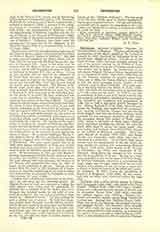

Chichester, Ancient CATHOLIC Diocese of (CICESTRENSIS), in England. This see took its rise in consequence of the decree passed at the Council of London in 1075, requiring all bishoprics to be removed from villages to towns. The old see of the South Saxons, which had been founded towards the end of the seventh century by St. Wilfrid of York, had been filled by a long line of bishops whose cathedral church was at Selsea. In consequence of the new decree, Stigand, Bishop of Selsea, transferred the see to Chichester in 1082. This town, called Regnum by the Romans, obtained its present name from Cissa, son of Aelle, the Saxon chieftain who landed in 477, the town becoming Cissa’s Ceaster, or fort (castrum), and, in time, Chichester. The most notable of the early bishops was Ralph de Luffa (1091-1123), who built the cathedral; much of the structure as it still exists was his work. In 1108 he was able to consecrate at least a part of it, but in 1114 the first fire occurred, and extensive rebuilding was necessary. The cathedral was completed and consecrated in 1184, but in 1186 it was again greatly damaged by fire. Bishop Seyffrid II (1180-1204), who had completed the building, now undertook its reconstruction, making considerable changes and introducing Early English work into the Norman building, which accounts for the composite character of the nave. His successor, Simon Fitz Robert of Wells (1204-1207), being a favorite of King John, obtained many important privileges for the see, but after his death John kept it vacant for many years. The next bishop was Richard Poore (1215-1217), known as the builder of Salisbury cathedral. After him came Ranulf of Warham (1217-1224) and Ralph Neville, the Chancellor (1224-1244), who was remarkable as a statesman. On his death there was a contest over the appointment to the see, which the pope settled by naming and consecrating Richard of Wych (1245-1253), better known as St. Richard of Chichester, the friend and chancellor of St. Edmund King Henry III, enraged at this, refused him the temporalities of his see. Having for a time been compelled to live on the alms of his own clergy, St. Richard ultimately succeeded in overcoming the king’s anger, and for eight years ruled the see with wisdom and holiness, his last act being to consecrate a church at Dover in honor of his friend and master, St. Edmund. In 1276, during the pontificate of Stephen of Berghsted (1262-1288), he was canonized, and his relics were enshrined above the high altar.
Chichester had another saintly prelate in Gilbert de S. Leophardo (1288-1305), who added to the Lady Chapel. William Rede (1369-1385) was a scholar-bishop who collected the early records of the see, and his namesake, Robert Rede (1397-1415) compiled the earliest register now existing. Bishops succeeded one another rapidly, many being transferred to other sees. Among them Reginald Pecock (1450-1459), famous for his learning, was accused of heresy and resigned his see. His successor, John Arundel (1459-1478), built the rood screen in the cathedral. But the diocese fell into bad condition, as is shown by the register of the next bishop, Edward Storey (1478-1503), a wise administrator who founded the Chichester grammar school. Robert Sherburne (1508-1536) made some protest against the encroachments of Henry VIII, but being unable to withstand them effectually, resigned the see, and was succeeded by the schismatic Richard Sampson (1536-1543), who in 1538 destroyed the shrine of St. Richard at the king’s command. The next bishop, George Day (1543-1557), though he had accepted schismatical institution from Henry VIII, yet proved a good Catholic, on which account he was imprisoned, and replaced by John Scory. Bishop Day regained his see, however, in 1554. He was succeeded by John Christopherson (1557-1559), the last Catholic Bishop of Chichester. After him the notorious William Barlow inaugurated the line of Anglican prelates. There were in the diocese two archdeaconries, Chichester and Lewes, and, according to the valuation made in 1291, which remained the basis of all valuations until the reign of Henry VIII, there were nearly three hundred parishes. Battle Abbey and Lewes Priory were the chief monasteries, and all the chief orders were well represented. One consequence of Sussex being originally so largely in the hands of Norman proprietors was the existence of an unusually large number of small priories dependent on houses in Normandy, such as the Abbey of Fecamp. The bishop had ten episcopal manors, and the Archbishop of Canterbury held the collegiate church of South Mailing and twenty-five parishes. The arms of the see were azure, a Presbyter John sitting on, a tombstone, iii his left hand a book open, his right hand extended, or, with a linen mitre on his head, and in his mouth a sword, all proper.
EDWIN BURTON

